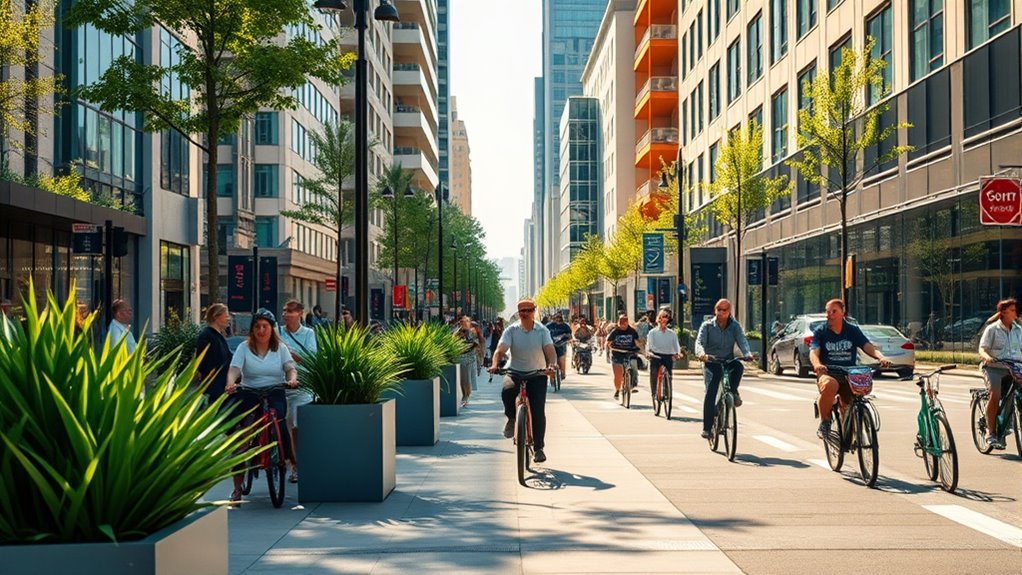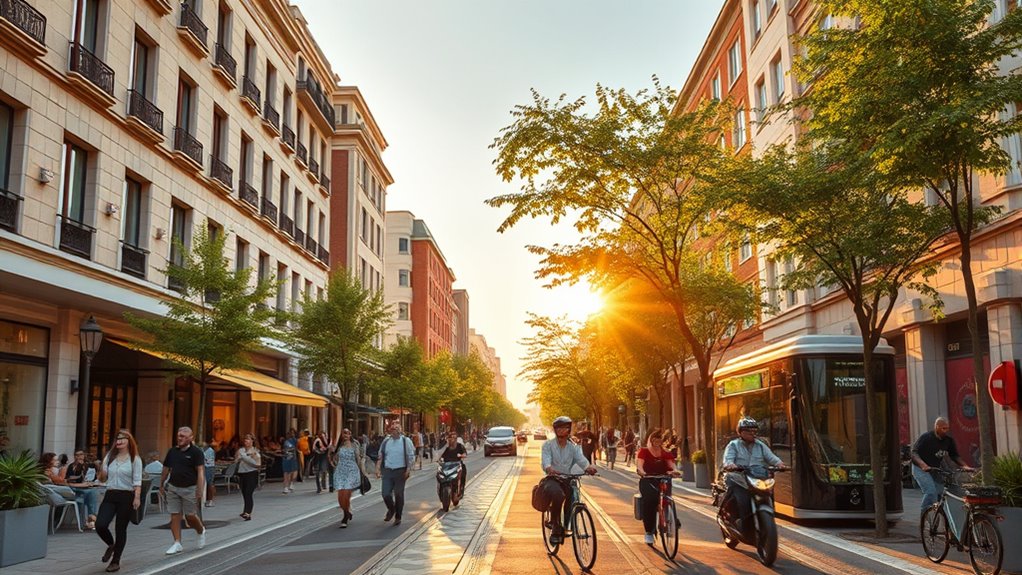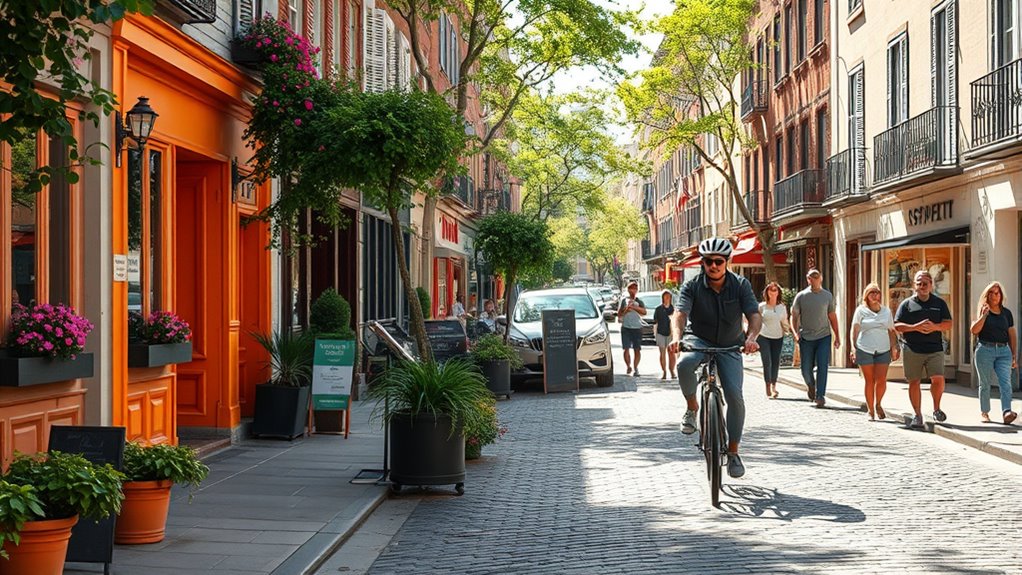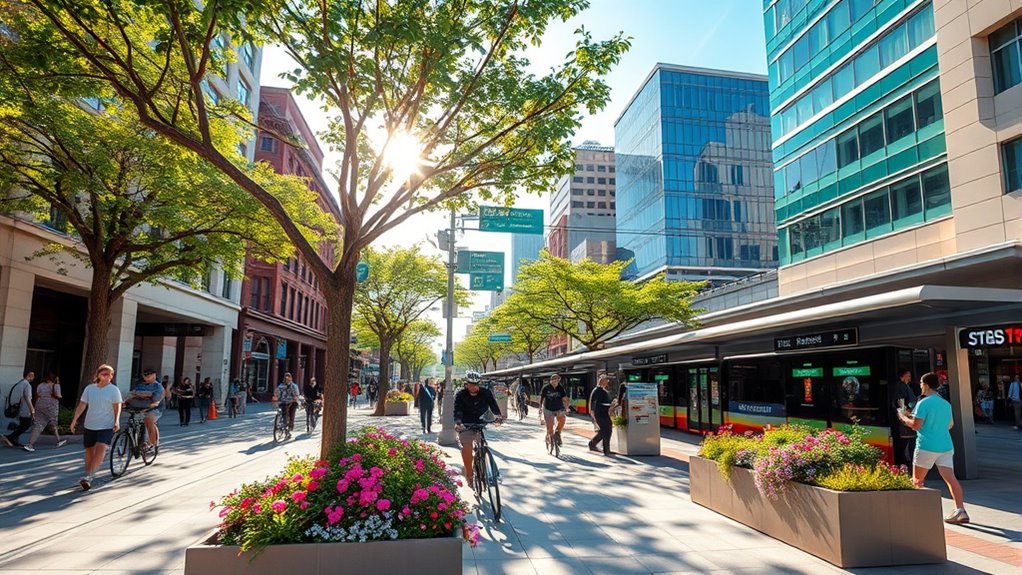Imagine a city that thrives without cars by prioritizing walkable neighborhoods, protected bike lanes, and car-free zones for community events. Extensive public transit connects everything smoothly, encouraging active lifestyles and reducing pollution. Streets transform into lively spaces, supporting local businesses and social bonds. This approach creates healthier, vibrant communities that adapt to climate challenges. Want to see how this urban success story unravels? Keep exploring to discover more.
Key Takeaways
- The city prioritizes walkable neighborhoods with mixed-use developments, reducing the need for personal vehicle use.
- Extensive public transit systems and bike networks provide reliable, convenient alternatives to driving.
- Car-free zones and public plazas foster vibrant community interactions and cultural events.
- Urban planning emphasizes green spaces, pedestrian corridors, and outdoor gathering areas to promote active lifestyles.
- Reduced reliance on cars improves air quality, health, and supports sustainable, resilient urban living.
A City Designed for Pedestrians and Cyclists

Have you ever wondered what a city built for pedestrians and cyclists looks like? Imagine streets designed to prioritize foot traffic and bike rides over cars. Sidewalks are wide, well-maintained, and interconnected, making walking seamless and safe. Bike lanes are protected and stretch across neighborhoods, encouraging residents to pedal rather than drive. Smart urban planning creates compact, mixed-use areas where shops, parks, and homes are within easy reach, reducing the need for vehicle trips. Car-free zones transform busy streets into lively public spaces, hosting markets, festivals, and community events. Public plazas and pedestrian-only corridors foster social interactions and cultural activities. Incorporating exotic fruit blends and fresh juice options can also enhance the vibrancy and appeal of these communal spaces. This kind of city promotes active lifestyles, improves air quality, and creates a vibrant, accessible environment for everyone. Additionally, integrating vertical storage solutions can help maximize space in urban environments, supporting a clutter-free and organized cityscape.
Public Transit as the Urban Backbone

Public transit systems serve as the essential backbone of sustainable urban mobility, connecting neighborhoods, workplaces, and recreational areas efficiently. You rely on buses, subways, and light rail to navigate the city without a car, reducing congestion and pollution. Cities like New York and Washington, D.C., operate extensive networks that support daily commutes and leisure trips, making car ownership unnecessary for many residents. Reliable transit options encourage walking and biking, fostering active lifestyles. Public transit also boosts economic activity by increasing accessibility to local businesses and cultural venues. When transit is convenient and well-maintained, you experience less stress and enjoy more time for yourself. Investing in robust transit infrastructure transforms the city into a connected, vibrant, and sustainable place to live without the need for personal vehicles.
Innovative Urban Planning and Community Spaces

Innovative urban planning transforms city spaces by prioritizing pedestrians, cyclists, and community interaction over car traffic. You’ll notice how cities create walkable neighborhoods with compact layouts, mixed-use developments, and accessible public spaces. San Francisco and New York, for example, convert streets into car-free zones that foster cultural events, markets, and outdoor gatherings, encouraging social bonds. Minneapolis’s winter-proof skyways connect buildings and shops, allowing year-round movement without cars. Community spaces like linear parks under transit lines and open plazas replace parking lots, making room for green areas and social interaction. These designs promote active lifestyles, strengthen neighborhood ties, and enhance urban vitality. Incorporating tableware into community events and outdoor markets further enriches social experiences and cultural expression. Additionally, the reallocation of space often includes public art and interactive installations that invite community participation. The use of urban design principles effectively encourages walkability and reduces reliance on vehicles, fostering a more sustainable environment. Moreover, these innovative designs can influence alimony laws by supporting flexible, community-oriented living arrangements that benefit diverse populations. By rethinking space allocation, cities foster inclusive, lively environments where community connection thrives without the need for cars.
Environmental and Health Advantages of Going Car-Free

When you choose to go car-free, you help improve air quality by reducing vehicle emissions. This shift encourages an active lifestyle, making it easier to walk or cycle more often. As a result, you’ll enjoy healthier living and cleaner urban environments. Incorporating antique decor into your surroundings can also create a cozy, inviting atmosphere that complements your eco-friendly lifestyle.
Improved Air Quality
Have you ever wondered how cities improve their air quality by reducing car traffic? When fewer vehicles clog the streets, emissions of pollutants like nitrogen oxides and particulate matter drop markedly. This means cleaner air for everyone, especially pedestrians and residents living nearby. In car-free zones or neighborhoods, the absence of exhaust fumes creates healthier breathing environments and reduces respiratory issues. Cities like Nuremberg have seen nearly a 25% decrease in traffic-related pollution, leading to clearer skies and more vibrant outdoor spaces. Less traffic also means fewer idling cars, which further cuts emissions. Overall, reducing car use allows urban areas to breathe easier, promoting cleaner environments and healthier communities. This shift makes a tangible difference in the air we all share. Implementing air quality management strategies can further enhance these benefits, ensuring sustained improvements in urban health. Additionally, promoting alternative transportation options such as cycling and walking can further reduce emissions and support healthier city living.
Active Lifestyle Benefits
Did you know that choosing a car-free lifestyle can considerably boost your physical health and benefit the environment? When you walk, bike, or use public transit, you incorporate more activity into your day, which improves cardiovascular health, strengthens muscles, and helps maintain a healthy weight. Cycling on well-maintained bike lanes, like those in Minneapolis or Berkeley, makes exercise enjoyable and accessible. Plus, reducing car trips cuts pollution and lowers your carbon footprint, helping combat climate change. Car-free cities often have more green spaces and pedestrian zones, encouraging outdoor activities and social interactions. This active lifestyle not only enhances your physical well-being but also promotes mental health by reducing stress and increasing opportunities to connect with your community. Additionally, exploring local hours today list can help you plan your outings efficiently, making it easier to adopt a car-free routine. Incorporating urban green spaces into your daily routine can further enhance your connection with nature and support a healthier lifestyle. Did you know that walking and biking can also help you discover local hidden gems, enriching your community experience? Engaging in community events can deepen your sense of belonging and promote social cohesion. For example, utilizing Ring Security Cameras can help you keep an eye on your home while you’re out enjoying outdoor activities. Embracing a car-free life truly supports a healthier, more vibrant you.
Social and Economic Benefits of Car-Free Neighborhoods

Car-free neighborhoods foster stronger community bonds by transforming public spaces into vibrant, pedestrian-centered areas where residents can socialize, gather, and participate in local events. Without cars clogging the streets, you’ll notice more interactions at markets, parks, and street festivals, boosting a sense of belonging. Local businesses thrive as foot and bike traffic increase, making it easier for you to support small shops and eateries nearby. Public transit and active transportation options lower your transportation costs, giving you more money for community activities. Events like OpenStreetsPGH draw crowds, creating lively environments that attract visitors and stimulate the local economy. By prioritizing walkability and shared spaces, these neighborhoods promote inclusivity, safety, and economic significance for everyone living there. Smart design also plays a key role in creating comfortable, welcoming living spaces that enhance residents’ well-being and community engagement. Additionally, implementing sustainable transportation options can further improve environmental health and reduce urban pollution, which is a crucial aspect of urban sustainability. Incorporating eco-friendly accommodations into urban planning can further support these goals by minimizing environmental impact and promoting eco-conscious lifestyles. Moreover, thoughtful farmhouse furniture choices can add charm and practicality to community spaces, fostering a warm and inviting atmosphere that encourages social interaction.
Overcoming Climate and Infrastructure Challenges

While the social and economic advantages of car-free neighborhoods are compelling, implementing these urban visions faces significant climate and infrastructure hurdles. You must adapt to diverse climatic conditions, like Miami’s heat or Minneapolis’s cold, with innovative solutions such as shaded linear parks or heated sidewalks. Ensuring reliable transit coverage in sprawling, car-dependent areas remains a challenge, requiring substantial investments in expanding and maintaining networks. Balancing visitor parking with residents’ needs demands creative shared parking strategies. Additionally, providing equitable access to e-bikes, transit passes, and safety infrastructure is vital to prevent disparities. Continuous funding and planning are essential to upgrade bike lanes, pedestrian pathways, and transit systems, making car-free living feasible and resilient in diverse environments. Understanding the refrigeration cycle can also support sustainable urban infrastructure by improving energy efficiency and reducing environmental impact. Moreover, considering urban planning strategies that incorporate flexible transportation options can further enhance resilience and accessibility in these communities. Recognizing the importance of integrated transportation systems ensures that mobility solutions are comprehensive and efficient, supporting the long-term success of car-free initiatives. Implementing innovative design principles can improve the overall livability and adaptability of these neighborhoods, especially in changing climates. Incorporating zoning laws that promote mixed-use development can facilitate walkability and reduce dependence on vehicles, further supporting sustainable urban living.
Lessons From Leading Examples Across the U.S

You can learn a lot from how cities across the U.S. are redesigning their spaces and improving transit to support car-free lifestyles. Innovative urban planning and transit solutions are making it easier for people to get around without cars. These examples reveal practical strategies that you can adapt to create more walkable, sustainable communities.
Urban Design Strategies
Urban design strategies play a crucial role in creating successful car-free cities by shaping how residents move, socialize, and access amenities. You should focus on creating dense, mixed-use neighborhoods that place shops, services, and workplaces within walking or biking distance. Incorporate extensive bike lane networks and protected pathways to encourage active transportation. Use street closures and pedestrian-only zones to foster community gatherings and enhance safety. Integrate climate-responsive features like covered walkways or indoor skyways to enable year-round mobility. Design public spaces that prioritize social interaction, such as parks and plazas, seamlessly connected through accessible routes. By thoughtfully planning these elements, you support a vibrant, sustainable urban environment that minimizes dependence on cars while maximizing community engagement.
Public Transit Innovations
Innovative public transit systems are essential for creating truly car-free cities, and across the U.S., leading examples demonstrate how strategic investments and technological advancements can transform urban mobility. Cities like New York and Washington have expanded bus, subway, and bike-share networks, making alternative transportation reliable and convenient. Salt Lake City combines e-bike stations, pedestrian-only zones, and strong transit usage, reducing reliance on cars. These innovations improve accessibility, cut emissions, and promote healthier lifestyles.
| City | Key Transit Features | Impact |
|---|---|---|
| New York | Largest bus/subway system, Citi Bike | Extensive mobility options |
| Washington, D.C. | Metro rail, bike-share, bus services | High transit ridership |
| Salt Lake City | E-bike stations, pedestrian streets | Reduced car dependency |
| San Francisco | Car-free streets, walkable neighborhoods | Enhanced community spaces |
Frequently Asked Questions
How Do Car-Free Cities Handle Emergency Vehicle Access Effectively?
You guarantee emergency vehicle access in car-free cities by designing wide, clearly marked routes that bypass pedestrian zones. You implement smart planning with specialized lanes, rapid response stations, and integrated transit systems like dedicated bus and ambulance corridors. Regular drills and community awareness programs help coordinate responders. These measures guarantee that emergency services can reach all areas quickly, maintaining safety without compromising the city’s car-free design.
What Strategies Ensure Equitable Transportation Options for All Residents?
You can’t afford to overlook equitable transportation in a car-free city—imagine every resident, from kids to seniors, easily reaching essential services without hassle. Prioritize affordable transit passes, expand bike and pedestrian infrastructure, and guarantee all neighborhoods are well-connected. Implement inclusive planning that considers diverse needs, and invest in community programs that promote access. These strategies create a city where everyone moves freely, safely, and fairly—no matter their income or physical ability.
How Do Cities Maintain Safety With Increased Pedestrian and Bike Activity?
You maintain safety by designing streets with clear, distinct lanes for bikes and pedestrians, using physical barriers to separate them from vehicles. Implementing well-lit crossings and traffic calming measures slows down cars in high-activity areas. Regularly enforcing traffic rules and educating drivers, bikers, and pedestrians also reduces accidents. Continuous maintenance of infrastructure and community engagement help guarantee everyone feels safe and confident traversing busy, car-free streets.
What Funding Models Support Ongoing Infrastructure Expansion and Maintenance?
You can support infrastructure expansion and maintenance through diverse funding models like dedicated transportation taxes, grants, public-private partnerships, and local government budgets. Many cities also leverage federal funds for transit projects and infrastructure upgrades. By advocating for these sources, you help guarantee consistent investment, allowing the city to expand bike lanes, improve sidewalks, and maintain public transit systems, ultimately creating a safer, more accessible, and sustainable environment for all residents.
How Are Tourism and Visitor Mobility Managed in Car-Free Urban Areas?
Ever wonder how visitors explore car-free cities? You’re likely to find well-designed transit options like bike-share programs, pedestrian-friendly streets, and frequent, accessible public transit that make getting around easy and enjoyable. Cities often promote walkable neighborhoods, offer tourist-friendly maps, and host events that attract visitors without cars. This seamless mobility enhances tourism experiences, making the city vibrant and accessible while reducing congestion and environmental impact.
Conclusion
As you explore this car-free city, you’ll realize how much potential lies beyond cars. Imagine a future where streets breathe, communities thrive, and sustainability takes center stage. But what if this model becomes the norm? The next breakthrough could reshape our lives in ways you never expected — if we dare to challenge the status quo. Are you ready to see what’s possible when we rethink our urban spaces? The answer might just surprise you.






